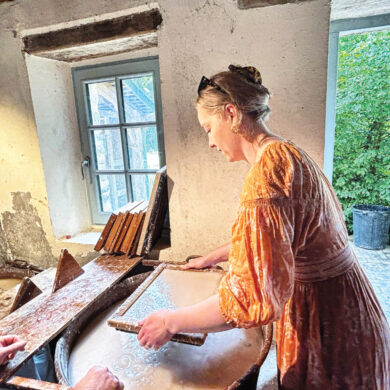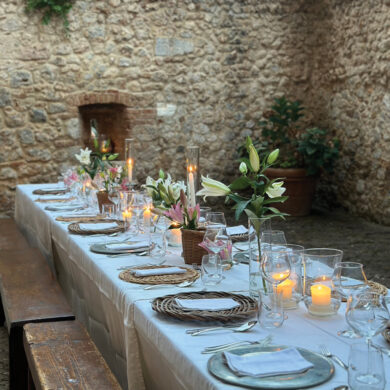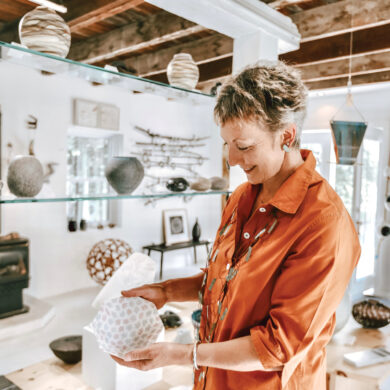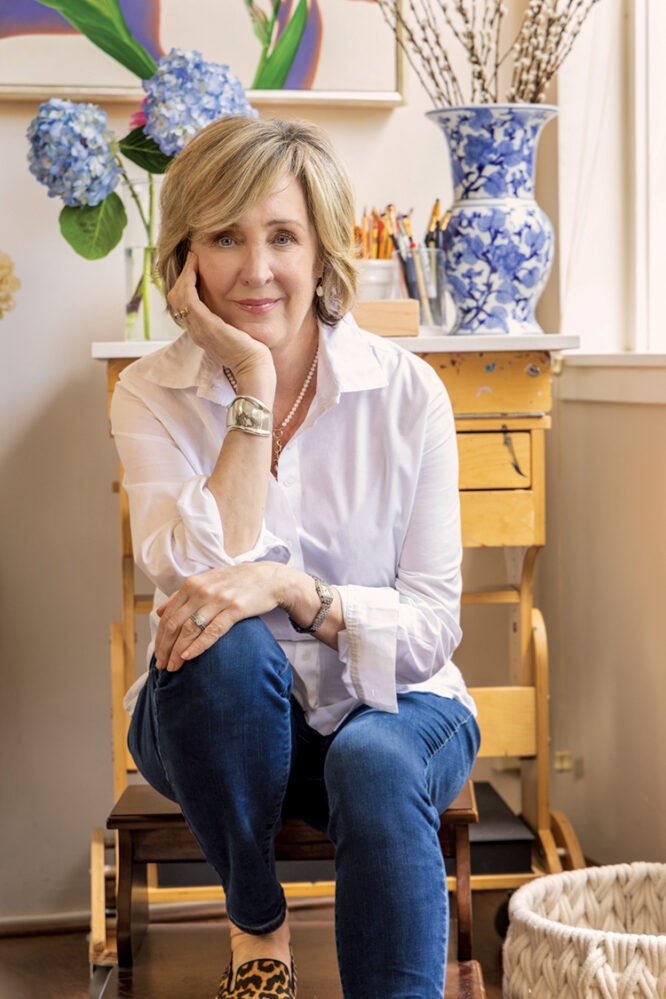
My studio is a twice-sacred space. It is my metaphorical sacred space, where I work each day in devotion to my calling and art. And it is also a literal sacred space, nestled inside an active church in the heart of our seaside village.
It feels miraculous each and every day to walk from our home in Carmel-by-the-Sea to my studio at Church of the Wayfarer in the center of the village. It is just a 15-minute stroll along streets dotted with fairytale houses and cottage gardens. But it was a long journey across several lifetimes (and studios) to this bright room tucked inside a historic church’s classroom space overlooking its abundant garden. In some ways, it seems inevitable that I am now painting flowers inside a church in a coastal town. But it certainly took a while to get here!
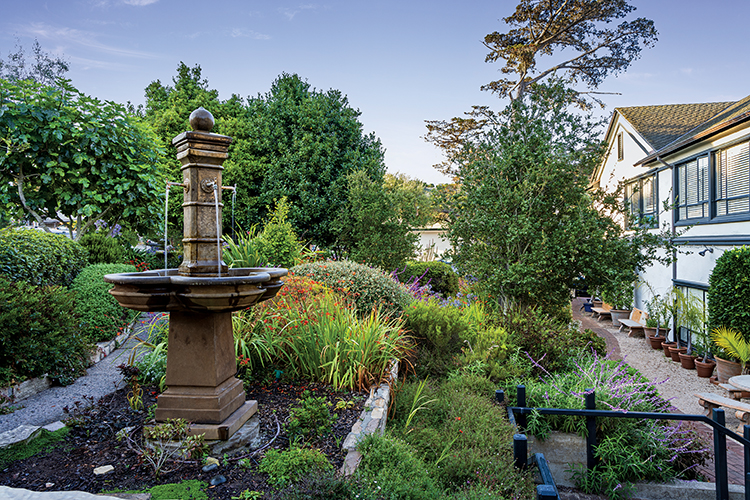
My late father, Philip Barlow, was a noted artist and I grew up in Salt Lake City, Utah, in a house filled with art. My mother was (and still is) a talented gardener. While every other house in our neighborhood had back lawns and swing sets, ours had a tiny pond, winding garden paths and flowers everywhere. You might think that I would have emerged as an artist right out of high school, but I had other ideas. Perhaps it was a bit of: Let’s not do what is expected of me.
So, I studied acting in college (and nearly moved to Los Angeles to pursue it), then pursued my passion for history with a master’s degree. I married my first husband and moved to Cambridge, England, where I tried my hand at writing. After a divorce and moving back to the States, I followed my passion for the performing arts and worked at both ballet and opera companies. Throughout all these adventures I drew and painted watercolors in the background of my other passions.
And then one day, quite suddenly, while living in San Francisco, I came to my senses and woke up to my calling. While sitting on a bench at the Bay’s edge looking at the clouds, these distinct words came to me: I am going to paint the sky. I went home and immediately called my father and said, “I want to start painting.” His advice to me was typically blunt and so right: “You have talent, but you need to study seriously.”
And so, I did. Over the next decade or so, I completed a post-baccalaureate program in painting; married the love of my life, Stephen McClellan; and painted in various studios all over San Francisco. My first studio was in a corner of my tiny Russian Hill studio apartment and my last was located just off the cable car line near Union Square (never mind that it was dark, and the neighborhood sometimes gritty).

My paintings at this time reflected our vibrant, bustling cosmopolitan lives in the city. I developed a series of paintings called Portraits in Absentia, in which I used my subjects’ belongings to create their portraits. For a portrait of a very tall, glamorous woman, I painted a collection of her extravagant shoes and titled it Portrait of a Glamazon.
Another painting was titled Portrait of a Marriage and used the wedding shoes of two men — a prominent composer and an actor — to celebrate their wedding.
My Portraits in Absentia paintings included golf balls, stilettos, lipsticks, books, opera scores, rosaries, ballet pointe shoes and footballs. I loved every minute of exploring my subjects’ lives through their belongings; it was a kind of archeology in paint.

When, in 2016, we decided to leave our bustling San Francisco lives and see what it would feel like to live in Carmel-by-the-Sea, a place we both knew and loved. Within a few months, we decided to stay, and my art practice was transformed.
My San Francisco world of opera, ballet and the hottest new restaurants was replaced by ocean mists, twisting cypresses, falling asleep to the sound of the sea and year-round flowers.
Almost immediately, I felt called to use flowers as my subjects, and so I began my Flora Portraits series. Some of these paintings are portraits of an individual flower, whose exaggerated presence in scale becomes a metaphor for grace, resilience and joy. Other paintings are memories of specific gardens, recalling their sunlight, tiny buds, fading blossoms and life-giving greens. Still others are portraits of people using flowers to symbolize various aspects of their lives. Each flower or garden I paint is a powerful individual presence to me and I try to evoke its inner essence and keep alive forever the messages it offers to the world.
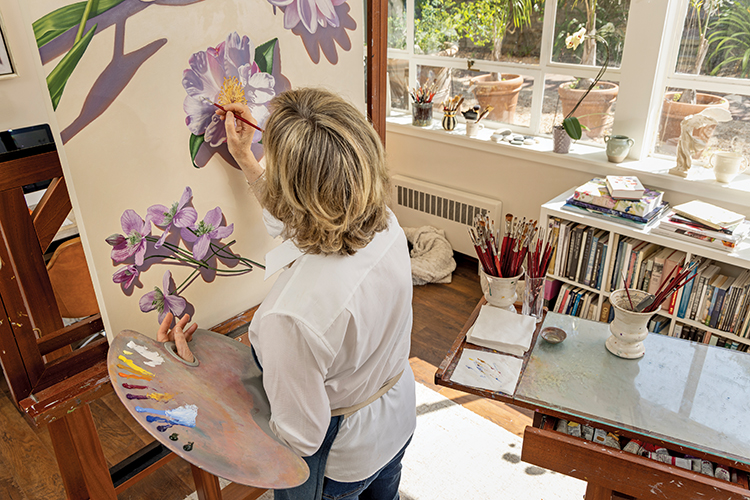
Something else happened in this journey to Carmel that changed my art forever. Not long after our move, I found a meditation group and began studying and practicing meditation each day. Now, meditation and painting flowers weave a tapestry that gives shape and sustenance to my days.
Meditation gives me the gift of gently releasing repetitive thoughts — Did I remember to call so-and-so? … Why did I say that? — and just simply residing in the beauty of the present moment. When I am truly awake to the now, I see the baby hummingbird in the shadows of the wisteria and hear the hawks cry overhead.
Painting flowers brings the same gifts to my life as meditation. When I take the time to look deeply at a flower as I paint it, I am awakened from the deep sleep of busyness and see the wonder of this flower, this sunlight, this breeze, this sky, this now. Meditation and painting flowers have both changed my life by giving me a sense of reverence that accompanies me throughout my day.
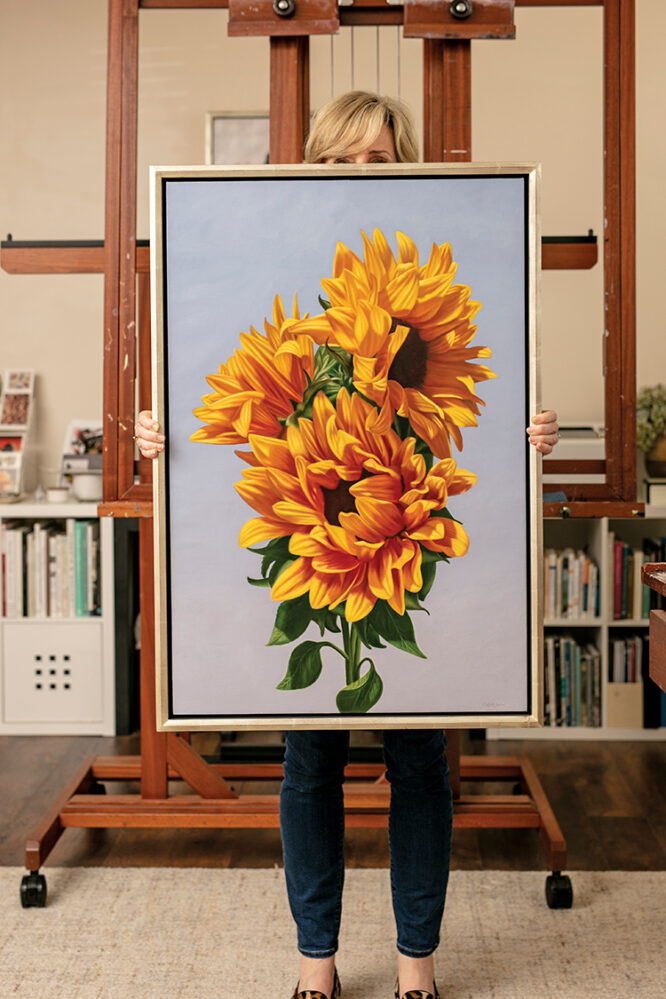
Something else amazing happened when I began painting flowers and meditating. For many years, I was hesitant to talk about “beauty” as an important part of my work. I wanted to be taken seriously as an artist and worried that, by invoking beauty, my work might be dismissed as superficial or trite.
Once I began spending my days looking deeply at flowers, I came to an important realization. Flowers use their beauty to seduce us into stopping and observing them. In this pause, our breathing slows, and we become truly present to the world around us.
As we begin to stop for beauty, we build our “awareness muscle” and seeing beauty becomes easier. Suddenly, it is everywhere around us and our days are suffused with an infinite capacity for joy and wonder. Flowers and beauty teach us how to pay attention to, and wake us up to, the miraculous world of being.

Each morning as I take my walk through Carmel to my studio, with my trusty studio assistant by my side (Chanel, the toy poodle), I remind myself that my job is to pay attention to beauty. People say to me, “You are so disciplined,” and I am always jarred by that description. Discipline is eating healthy or going to the gym. I am not disciplined about my art: I am devoted to my calling. Just like a ballet dancer, or a musician, I show up every day out of service to the art. And it is in the everyday actions and rituals, repeated over and over again, that magic emerges.
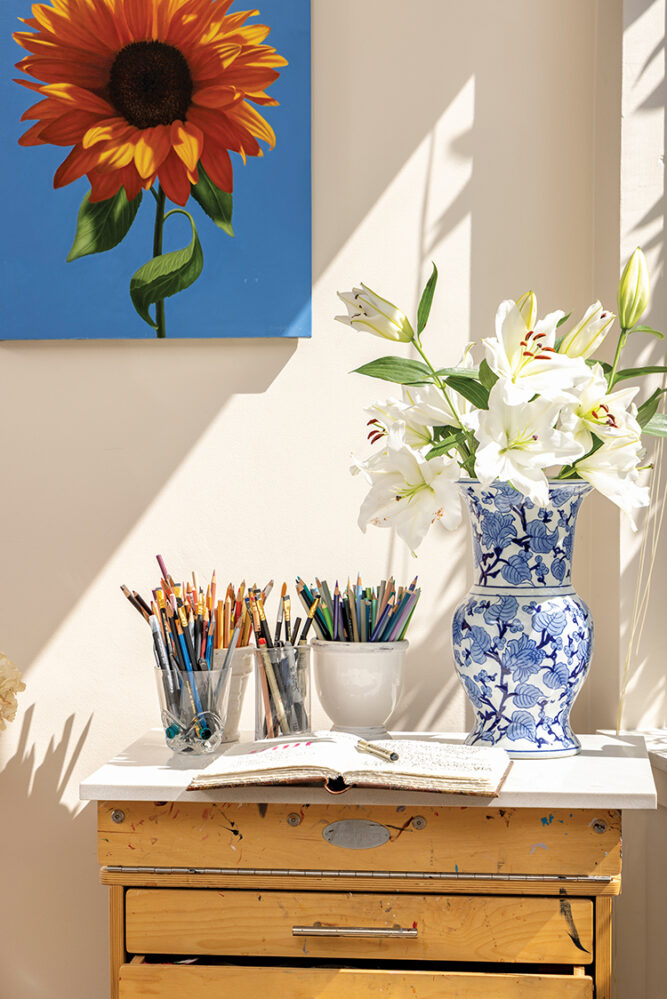
“There are always flowers, for those who want to see them.”
– Henri Matisse

Because my work is so detailed, each painting takes a long time to complete. I paint slowly by necessity and by intention. I want to linger in the moment of each step of my process. When I begin a painting, I spend several days or weeks gathering flowers and “playing” with them. I want to see them in early morning or late afternoon light, when the shadows are long and tinged with violet. I can often be seen outside my studio following the sun, arranging flowers and trying to keep them from wilting.
When I begin playing with the flowers, I have an idea of how I want the composition to look. And nearly every time, the flowers, the light and serendipity lead me in a different direction. Eventually, after several days, I will find an arrangement that sings to me. Or does it find me? Then I photograph the composition for my reference photos, put the flowers in vases in my studio to be my companions, and get to work on the canvas.

My studio days are stitched together with beloved rituals. Always, I open the blinds to the garden view, brew a cup of green tea in my giant cup, prepare my palette, mix the paint, turn on an audiobook and see where the flowers on the canvas lead me. When I am stuck or tired, I pick up one of my hundreds of art books and ask for renewal. A short pause with a fresh cup of tea, Chanel on my lap and a few pages of one of my many Georgia O’Keeffe books, and I am always re-centered. I am not seeking inspiration, only reawakening.
Inspiration will always come and find me when I am at the easel.

My studio is a twice-sacred space. It is my metaphorical sacred space, where I work each day in devotion to my calling and art. And it is also a literal sacred space, nestled inside an active church in the heart of our seaside village.
It feels miraculous each and every day to walk from our home in Carmel-by-the-Sea to my studio at Church of the Wayfarer in the center of the village. It is just a 15-minute stroll along streets dotted with fairytale houses and cottage gardens. But it was a long journey across several lifetimes (and studios) to this bright room tucked inside a historic church’s classroom space overlooking its abundant garden. In some ways, it seems inevitable that I am now painting flowers inside a church in a coastal town. But it certainly took a while to get here!

My late father, Philip Barlow, was a noted artist and I grew up in Salt Lake City, Utah, in a house filled with art. My mother was (and still is) a talented gardener. While every other house in our neighborhood had back lawns and swing sets, ours had a tiny pond, winding garden paths and flowers everywhere. You might think that I would have emerged as an artist right out of high school, but I had other ideas. Perhaps it was a bit of: Let’s not do what is expected of me.
So, I studied acting in college (and nearly moved to Los Angeles to pursue it), then pursued my passion for history with a master’s degree. I married my first husband and moved to Cambridge, England, where I tried my hand at writing. After a divorce and moving back to the States, I followed my passion for the performing arts and worked at both ballet and opera companies. Throughout all these adventures I drew and painted watercolors in the background of my other passions.
And then one day, quite suddenly, while living in San Francisco, I came to my senses and woke up to my calling. While sitting on a bench at the Bay’s edge looking at the clouds, these distinct words came to me: I am going to paint the sky. I went home and immediately called my father and said, “I want to start painting.” His advice to me was typically blunt and so right: “You have talent, but you need to study seriously.”
And so, I did. Over the next decade or so, I completed a post-baccalaureate program in painting; married the love of my life, Stephen McClellan; and painted in various studios all over San Francisco. My first studio was in a corner of my tiny Russian Hill studio apartment and my last was located just off the cable car line near Union Square (never mind that it was dark, and the neighborhood sometimes gritty).

My paintings at this time reflected our vibrant, bustling cosmopolitan lives in the city. I developed a series of paintings called Portraits in Absentia, in which I used my subjects’ belongings to create their portraits. For a portrait of a very tall, glamorous woman, I painted a collection of her extravagant shoes and titled it Portrait of a Glamazon.
Another painting was titled Portrait of a Marriage and used the wedding shoes of two men — a prominent composer and an actor — to celebrate their wedding.
My Portraits in Absentia paintings included golf balls, stilettos, lipsticks, books, opera scores, rosaries, ballet pointe shoes and footballs. I loved every minute of exploring my subjects’ lives through their belongings; it was a kind of archeology in paint.

When, in 2016, we decided to leave our bustling San Francisco lives and see what it would feel like to live in Carmel-by-the-Sea, a place we both knew and loved. Within a few months, we decided to stay, and my art practice was transformed.
My San Francisco world of opera, ballet and the hottest new restaurants was replaced by ocean mists, twisting cypresses, falling asleep to the sound of the sea and year-round flowers.
Almost immediately, I felt called to use flowers as my subjects, and so I began my Flora Portraits series. Some of these paintings are portraits of an individual flower, whose exaggerated presence in scale becomes a metaphor for grace, resilience and joy. Other paintings are memories of specific gardens, recalling their sunlight, tiny buds, fading blossoms and life-giving greens. Still others are portraits of people using flowers to symbolize various aspects of their lives. Each flower or garden I paint is a powerful individual presence to me and I try to evoke its inner essence and keep alive forever the messages it offers to the world.

Something else happened in this journey to Carmel that changed my art forever. Not long after our move, I found a meditation group and began studying and practicing meditation each day. Now, meditation and painting flowers weave a tapestry that gives shape and sustenance to my days.
Meditation gives me the gift of gently releasing repetitive thoughts — Did I remember to call so-and-so? … Why did I say that? — and just simply residing in the beauty of the present moment. When I am truly awake to the now, I see the baby hummingbird in the shadows of the wisteria and hear the hawks cry overhead.
Painting flowers brings the same gifts to my life as meditation. When I take the time to look deeply at a flower as I paint it, I am awakened from the deep sleep of busyness and see the wonder of this flower, this sunlight, this breeze, this sky, this now. Meditation and painting flowers have both changed my life by giving me a sense of reverence that accompanies me throughout my day.

Something else amazing happened when I began painting flowers and meditating. For many years, I was hesitant to talk about “beauty” as an important part of my work. I wanted to be taken seriously as an artist and worried that, by invoking beauty, my work might be dismissed as superficial or trite.
Once I began spending my days looking deeply at flowers, I came to an important realization. Flowers use their beauty to seduce us into stopping and observing them. In this pause, our breathing slows, and we become truly present to the world around us.
As we begin to stop for beauty, we build our “awareness muscle” and seeing beauty becomes easier. Suddenly, it is everywhere around us and our days are suffused with an infinite capacity for joy and wonder. Flowers and beauty teach us how to pay attention to, and wake us up to, the miraculous world of being.

Each morning as I take my walk through Carmel to my studio, with my trusty studio assistant by my side (Chanel, the toy poodle), I remind myself that my job is to pay attention to beauty. People say to me, “You are so disciplined,” and I am always jarred by that description. Discipline is eating healthy or going to the gym. I am not disciplined about my art: I am devoted to my calling. Just like a ballet dancer, or a musician, I show up every day out of service to the art. And it is in the everyday actions and rituals, repeated over and over again, that magic emerges.

“There are always flowers, for those who want to see them.”
– Henri Matisse

Because my work is so detailed, each painting takes a long time to complete. I paint slowly by necessity and by intention. I want to linger in the moment of each step of my process. When I begin a painting, I spend several days or weeks gathering flowers and “playing” with them. I want to see them in early morning or late afternoon light, when the shadows are long and tinged with violet. I can often be seen outside my studio following the sun, arranging flowers and trying to keep them from wilting.
When I begin playing with the flowers, I have an idea of how I want the composition to look. And nearly every time, the flowers, the light and serendipity lead me in a different direction. Eventually, after several days, I will find an arrangement that sings to me. Or does it find me? Then I photograph the composition for my reference photos, put the flowers in vases in my studio to be my companions, and get to work on the canvas.

My studio days are stitched together with beloved rituals. Always, I open the blinds to the garden view, brew a cup of green tea in my giant cup, prepare my palette, mix the paint, turn on an audiobook and see where the flowers on the canvas lead me. When I am stuck or tired, I pick up one of my hundreds of art books and ask for renewal. A short pause with a fresh cup of tea, Chanel on my lap and a few pages of one of my many Georgia O’Keeffe books, and I am always re-centered. I am not seeking inspiration, only reawakening.
Inspiration will always come and find me when I am at the easel.











